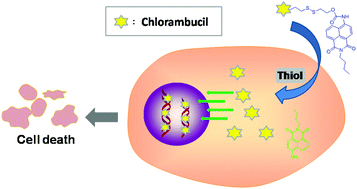Thiol-inducible direct fluorescence monitoring of drug release†
Abstract
A new bifunctional compound NCC, which undergoes

* Corresponding authors
a
College of Chemistry and Molecular Sciences, Key Laboratory of Biomedical Polymers of Ministry of Education, State Key Laboratory of Virology, Wuhan University, Hubei, Wuhan, P. R. China
E-mail:
xzhou@whu.edu.cn
Fax: +86-27-87336380
Tel: +86-27-61056559
b State Key Laboratory of Natural and Biomimetic Drugs, Beijing University, P. R. China
A new bifunctional compound NCC, which undergoes

 Please wait while we load your content...
Something went wrong. Try again?
Please wait while we load your content...
Something went wrong. Try again?
J. Wu, R. Huang, C. Wang, W. Liu, J. Wang, X. Weng, T. Tian and X. Zhou, Org. Biomol. Chem., 2013, 11, 580 DOI: 10.1039/C2OB26680F
To request permission to reproduce material from this article, please go to the Copyright Clearance Center request page.
If you are an author contributing to an RSC publication, you do not need to request permission provided correct acknowledgement is given.
If you are the author of this article, you do not need to request permission to reproduce figures and diagrams provided correct acknowledgement is given. If you want to reproduce the whole article in a third-party publication (excluding your thesis/dissertation for which permission is not required) please go to the Copyright Clearance Center request page.
Read more about how to correctly acknowledge RSC content.
 Fetching data from CrossRef.
Fetching data from CrossRef.
This may take some time to load.
Loading related content
